【C++STL :string类 (二) 】从接口应用到内存模型的全面探索
【C++STL :string类 (二) 】从接口应用到内存模型的全面探索

艾莉丝努力练剑
发布于 2025-11-13 11:17:18
发布于 2025-11-13 11:17:18
🔥艾莉丝努力练剑:个人主页
❄专栏传送门:《C语言》、《数据结构与算法》、C/C++干货分享&学习过程记录、Linux操作系统编程详解、笔试/面试常见算法:从基础到进阶
⭐️为天地立心,为生民立命,为往圣继绝学,为万世开太平
🎬艾莉丝的简介:

C++的两个参考文档
老朋友(非官方文档):cplusplus 官方文档(同步更新):cppreference

目录
3 ~> string 的进阶用法与技巧:string类的常见接口介绍说明
3.7 vs 和 g++下string结构的说明
3.7.1 vs下string的结构
3.7.2 g++下string的结构
3.8 打开文件
3.9 first_开头的四个接口
3.10 运算符重载
3.11 compare和npos
3.12 operator+
3.13 流插入、流提取
3.14 迭代器和指针
3.15 本章节必刷算法题
4 ~> string底层揭秘:懂原理,才能用得恰到好处
4.1 检查抛异常
4.2 命名空间
4.3 为什么像operator+这类函数要重载到全局
4.4 比较大小
4.5 clear( )
4.6 string类的三个swap
4.7 operator+=
4.8 insert && erase && find && substr && push_back && append
4.8.1 insert
4.8.2 erase
4.8.3 find
4.8.4 substr
4.8.5 push_back
4.8.6 append
4.9 resize:修改数据
4.10 reserve:扩容
4.11 为什么strcpy要改成memcpy || memmove?
4.12 getline
4.13 挪动数据(示意图)
4.14 string s2(s1)
5 ~> String类的实现:深拷贝与浅拷贝的隐患与解决
5.1 引子
编辑
5.2 浅拷贝
5.3 深拷贝
5.3.1 传统写法的string类
5.3.2 现代版写法的string类
5.3.3 SBO && 小buffer优化
5.4 写时拷贝
5.4.1 引用计数写时拷贝
5.4.2 向大佬学习
5.4.3 扩展阅读
6 ~> 本文完整代码
1 使用层面剩余代码实现
Test.cpp:
2 string类底层实现
string.h:
string.cpp:
Test.cpp:
结尾
3 ~> string 的进阶用法与技巧:string类的常见接口介绍说明
3.7 vs 和 g++下string结构的说明
注意:下述结构是在32位平台下进行验证,32位平台下指针占4个字节。
3.7.1 vs下string的结构
string总共占28个字节,内部结构稍微复杂一点,先是有一个联合体,联合体用来定义string中字符串的存储空间:
(1)当字符串长度小于16时,使用内部固定的字符数组来存放; (2)当字符串长度大于等于16时,从堆上开辟空间。
union _Bxty
{ // storage for small buffer or pointer to larger one
value_type _Buf[_BUF_SIZE];
pointer _Ptr;
char _Alias[_BUF_SIZE]; // to permit aliasing
} _Bx;这种设计也是有一定道理的,大多数情况下字符串的长度都小于16,那string对象创建好之后,内部已经有了16个字符数组的固定空间,不需要通过堆创建,效率高。
其次:还有一个 size_t 字段保存字符串长度,一个size_t字段保存从堆上开辟空间总的容量。
最后:还有一个指针做一些其他事情。 故总共占16+4+4+4=28个字节。
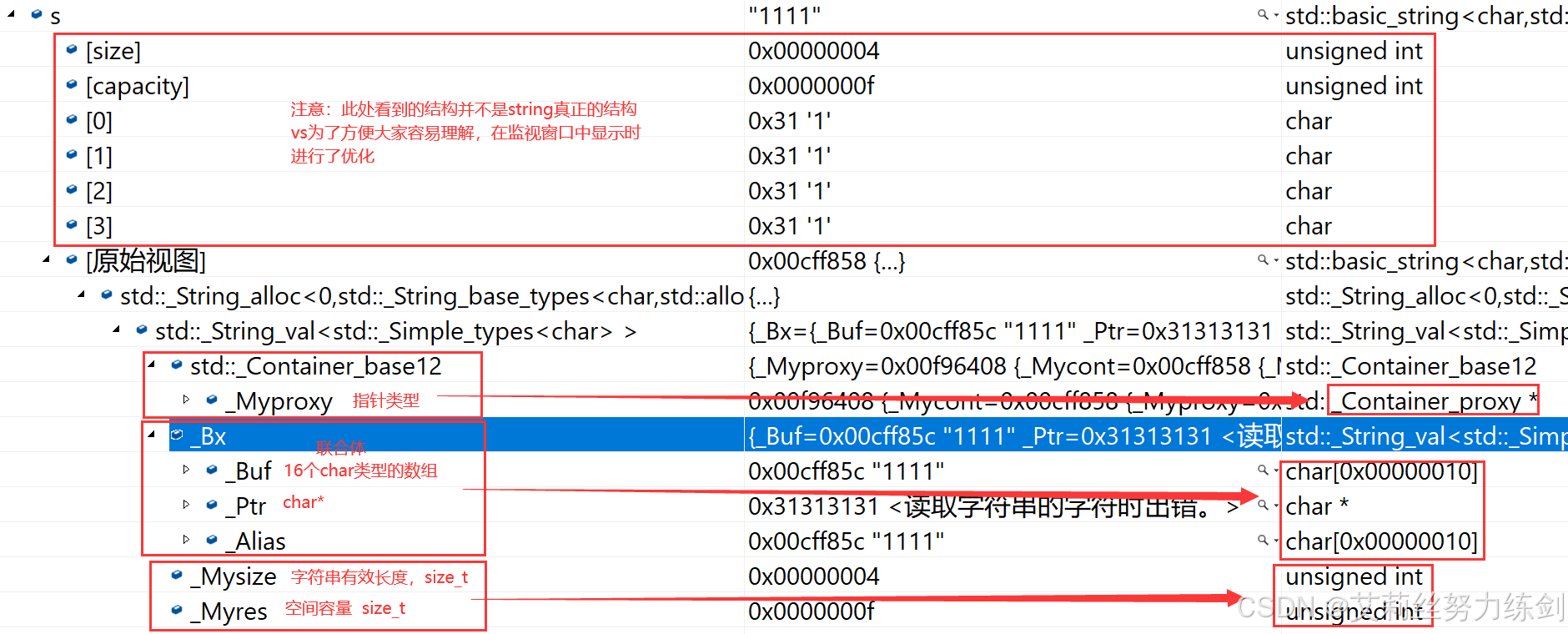
3.7.2 g++下string的结构
g++下,string是通过写时拷贝实现的,string对象总共占4个字节,内部只包含了一个指针,该指针将来指向一块堆空间,内部包含了如下字段:
(1)空间总大小; (2)字符串有效长度; (3)引用计数;
struct _Rep_base
{
size_type _M_length;
size_type _M_capacity;
_Atomic_word _M_refcount;
};(4)指向堆空间的指针,用来存储字符串。
3.8 打开文件
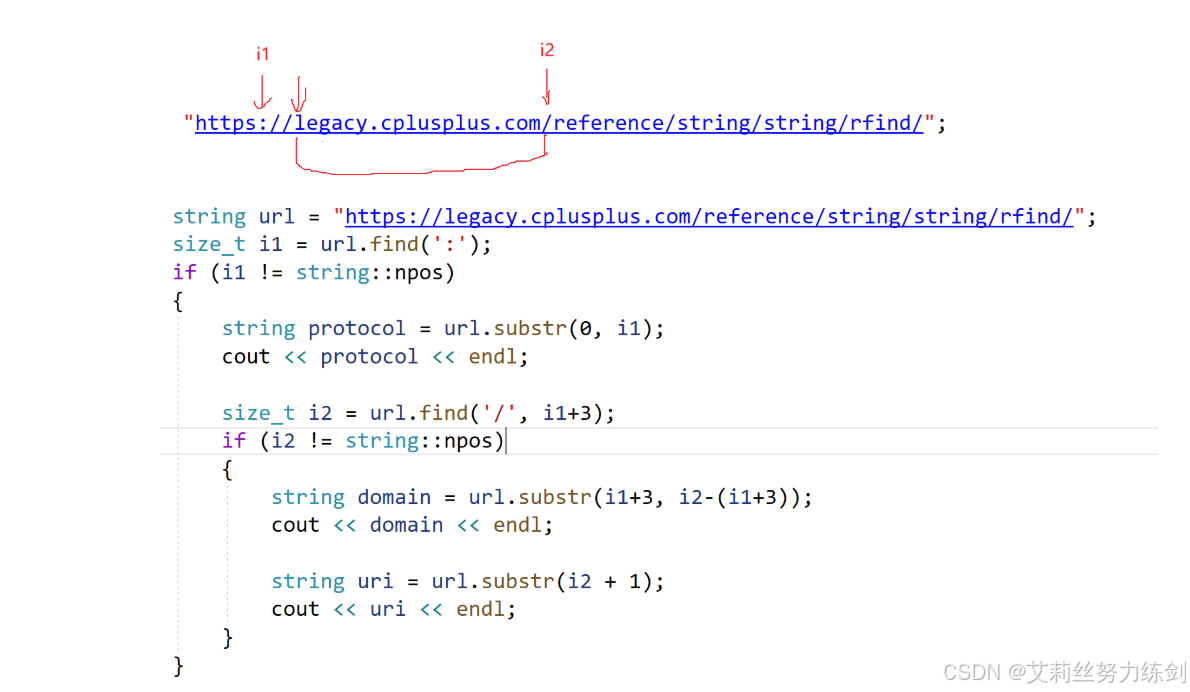
string filename("Test.cpp");
FILE* fout = fopen(filename.c_str(), "r");
if (fout)
{
cout << "打开文件成功" << endl;
}send:网络的接口,给别人发送东西要调用; string str("hello world"); send(str.c_str()); // c_str,最核心的就是如果是C语言风格的接口,就能很好的兼容
一般用c_str就不太用data了。 get_allocator:可以获取内部用的内存池,allocator就是内部的内存池对象。 allocator<T>给的是缺省参数,可以自己写一个申请内存释放内存的内存池,传过去的就是你的了——给你一个空间,让你可以选择用别人写的,也可以说觉得别人写得不行,用你自己的。
std::string::copy我们一般用string::substr——这个很好用——拷贝从pos位置开始的len个字符这样一部分,构造一个string对象返回。
string suffix = filename.substr(4, 4);不用给第二个缺省参数,默认取到结尾。
string suffix = filename.substr(4);
cout << suffix << endl;由此可见这个substr比copy好用多了,我们就不用这个copy。
万一给了这样一个文件——
string filename("Testabxxxx.cpp");
FILE* fout = fopen(filename.c_str(), "r");
if (fout)
{
cout << "打开文件成功" << endl;
}查找——
//查找
//size_t pos = filename.find('.');//没找到返回npos
//if (pos != string::npos)
//{
// string suffix = filename.substr(4);
// cout << suffix << endl;
//}比如说给了个Test.c——
string file("Test.c");
size_t pos = file.find('.');
if (pos != string::npos)
{
string suffix = file.substr(4);
cout << suffix << endl;
}比如说给了个多个后缀名,如Test.tar.zip这样的——那我们就倒着找:rfind(倒着往前找)——
string file("Test.tar.zip");比如说给了个多个后缀名,如Test.tar.zip这样的——那我们就倒着找:rfind(倒着往前找)——
string file("Test.tar.zip");
//如果只想找.zip
size_t pos = file.rfind('.');//没找到也是返回npos
if (pos != string::npos)
{
string suffix = file.substr(pos);
cout << suffix << endl;
}找个现实当中样例更复杂一点的,比如说URL—— 一个网址 —— Linux网络里面会接触:
string url = "https://legacy.cplusplus.com/reference/string/string/rfind/";协议:https;域名:legacy.cplusplus.com;域名之下的内容:reference/string/string/rfind/ 协议/域名(要发向的网址的服务器地址是什么,通过协议转换为IP)/内容; http 和 https的区别:https是加密过的,更加安全。
size_t i1 = url.find(":") ;//假设第一个位置叫i1,i1指向“:”取到这个网络(network)协议(protocol)的子串。
if (i1 != string::npos)
{
string protocol = url.substr(0, i1);//左闭右开,直接减——开区间位置减去闭区间位置就是个数
//用substr空间它底层会自己管理,copy这里有个char*指针,用多少空间还得自己算,substr自己会管理空间何乐而不为?
// 所以说copy不好用,我们一般不会去用
cout << protocol << endl;//获取到协议的名称:https
//假设要找域名,“/”不好找,但是所有的协议有一个特点:格式是定死的——协议后面是“:”,“:”后面是两个“/”
//find可以指定从pos位置开始找,我们就指定在两个“/”后面开始找,找此时后面第一个“/”,即从i1+3位置(://)开始找
size_t i2 = url.find('/', i1 + 3);
if (i2 != string::npos)
{
//取出域名
string domain = url.substr(i1 + 3, i2 - (i1 + 3));
cout << domain << endl;//domain:域名
//取出第三部分:一般称之为“资源”——了解了网络就知道了
string uri = url.substr(i2 + 1);//没必要算结尾的位置了,直接substr
cout << uri << endl;
//通过find、rfind、substr配合,就可以把协议的经典的三个部分分隔开,并且取出来
//可见在实践中在分割字符串等方面还是非常有用的
}
}3.9 first_开头的四个接口
下面这四个【string operations】接口了解一下即可,基本上用不到——
find_first_of
只要是源字符串里面有任意一个find_first_of子串里面的字符,就都返回;我们都比对一遍,是子串里面的就要修改成'*',不是就不动,返回的时候在子串里面的就修改成'*'了;不是取到第一个,实际上这个接口的表述有问题,应该叫find_any_of才比较恰当;为什么不改?语言的向前兼容问题——已经发布好几年了,不敢轻易改动。这个接口用得不多。
find_last_of
和 find_first_of 的区别就是它是倒着往前找的,实际上应该叫 rfind_first_of 才对。
find_first_not_of
比如"abcdefasfgsa"这样一个字符串返回,比如说要找abcde就只保留abcde,其余修改; 也就是说给一个子串,和源串对比,是就保留,不是就修改。
find_last_not_of
正好和find_first_not_of反过来。
std::string str("Please,replace the vowels in this sentence by asterisks.");
std::size_t found = str.find_first_not_of("aeiou");
while (found != std::string::npos)
{
str[found] = '*';
found = str.find_first_not_of("aeiou", found + 1);
}
std::cout << str << '\n';3.10 运算符重载
运算符重载用起来香——
cout << str < url << endl;运算符优先级的问题,会先比较左边。
cout << (str < url) << endl;按字典——ASCII码表比较。
这里从小写的h和大写的P开始比较(h大,大写在前,小写在后)。 比较ASCII码值,字符没办法字符是无法存储的,字符底层是查ASCII码表,看字符映射的整型值,即字符的ASCII码值。
不重载成成员函数而重载成全局的目的就是:这样不同类型之间也可以比较:比如说string可以和const char*比较。
3.11 compare和npos
compare和npos都不看了。
3.12 operator+
operator+是以非成员函数重载的:
operator+和operator+=的区别就是:“+”不改变自己,“+=”要改变自己 成员函数实现不了:传参第一个一定是str。
cout << str + "xxxxx" << endl;
cout << str + url << endl;
cout << "xxxxx" + str + url << endl;当心:传值返回 —— 代价要大一些,返回的是传值对象的拷贝。
不过,现在的编译器不用担心,C++11之后编译器有优化,效率很高。
C++11以后,传值返回对象效率都很不错——
string ret = str + "xxxxxx";//引用3.13 流插入、流提取

流插入、流提取:operator>>(cin)、operator<<(cout)。 注意:输入多个字符串,默认是" "或者endl/'\n'换行去间隔。
cin >> url >> str;
cout << url << endl;
cout << str << endl;遇到空格或者换行,编译器就认为这一次的输入就结束了。
输入xxxx yyyy,xxxx就进入到url里面,yyyy就进入到str里面。
getline,换行不结束,甚至可以自己控制什么时候结束。
swap:这个阶段不结合底层讲不清楚,下面我们介绍底层的时候还会再细说。
3.14 迭代器和指针
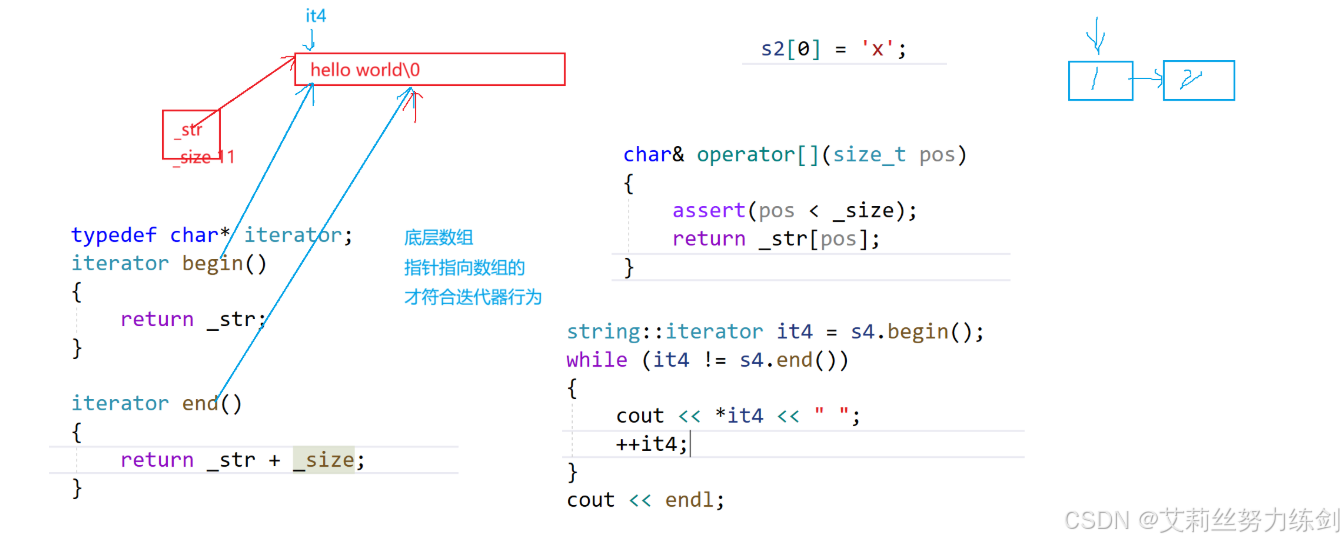
3.15 本章节必刷算法题
1、917. 仅仅反转字母 2、125. 验证回文串 3、415. 字符串相加 4、43. 字符串相乘 5、541. 反转字符串 II 6、557. 反转字符串中的单词 III 7、LCR 192. 把字符串转换成整数 (atoi) 8、HJ1 字符串最后一个单词的长度
4 ~> string底层揭秘:懂原理,才能用得恰到好处
在前面的介绍中,博主已经对string类进行了简单的介绍,uu们只要能够正常使用即可。在面试当中,面试官总喜欢让学生自己来模拟实现string类,最主要是实现string类的构造、拷贝构造、赋值运算符重载以及析构函数(~string)。
为什么要介绍底层?会用不就好了吗?哈哈,确实如此,但是光会用是不够的,只有我们懂得原理了,才能够用得恰到好处,之前数据结构的学习就是这样的道理。

我们今天继续来结合着string的文档来实现一下string类的底层。
4.1 检查抛异常

这里就只展现一下main函数里面检查抛异常的语句的代码——
int main()
{
//try{}catch(const excetion& e){}——抛异常
try
{
//jqj:自己定义的命名空间
jqj::test_string3();
//cout << typeid(jqj::string::iterator).name() << endl;
//cout << typeid(std::string::iterator).name() << endl;
}
catch (const exception& e)//exception:异常
{
cout << e.what() << endl;
}
return 0;
}4.2 命名空间
我们说过,使用相同的命名空间编译器会认为是同一个文件。
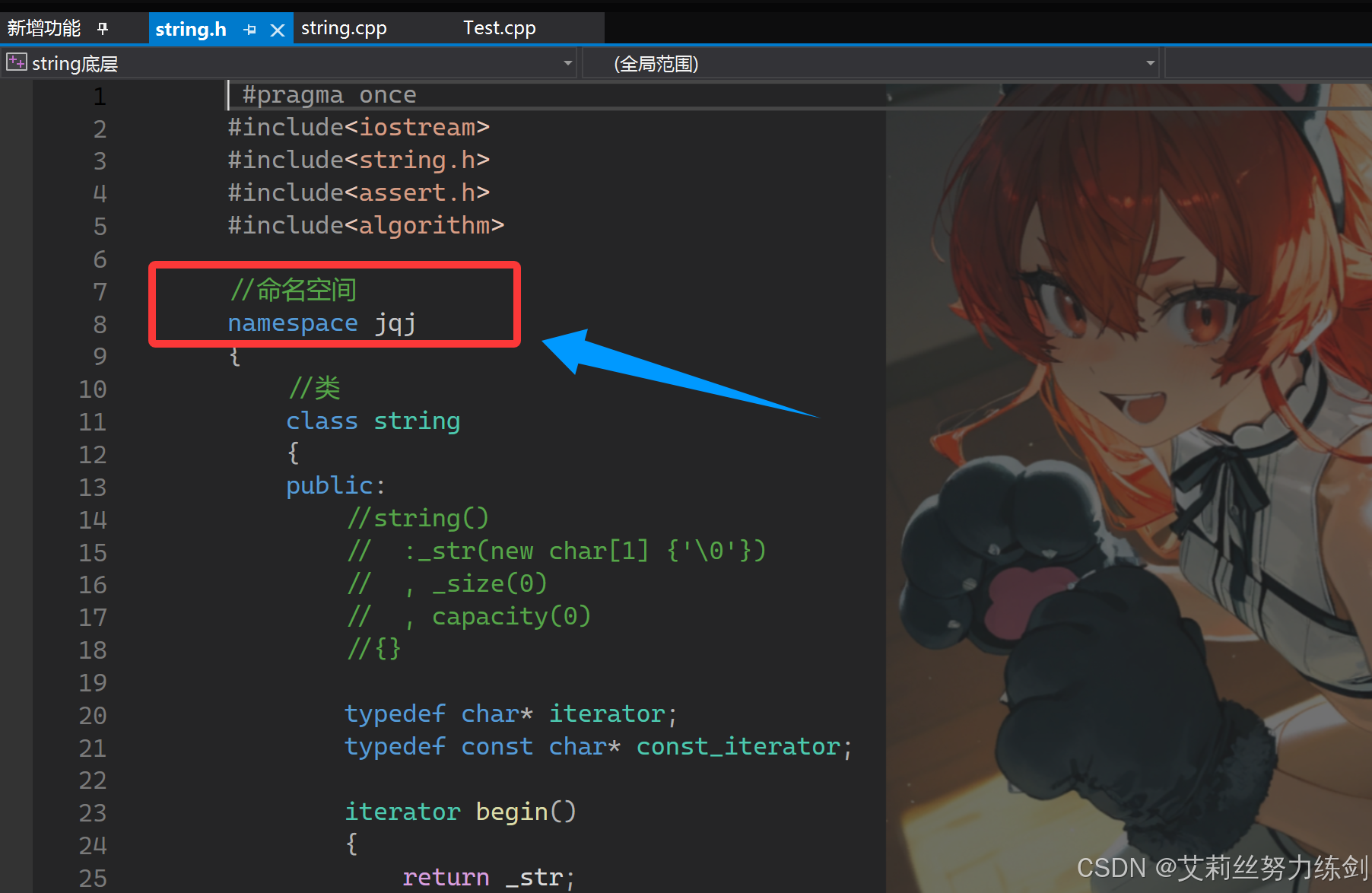
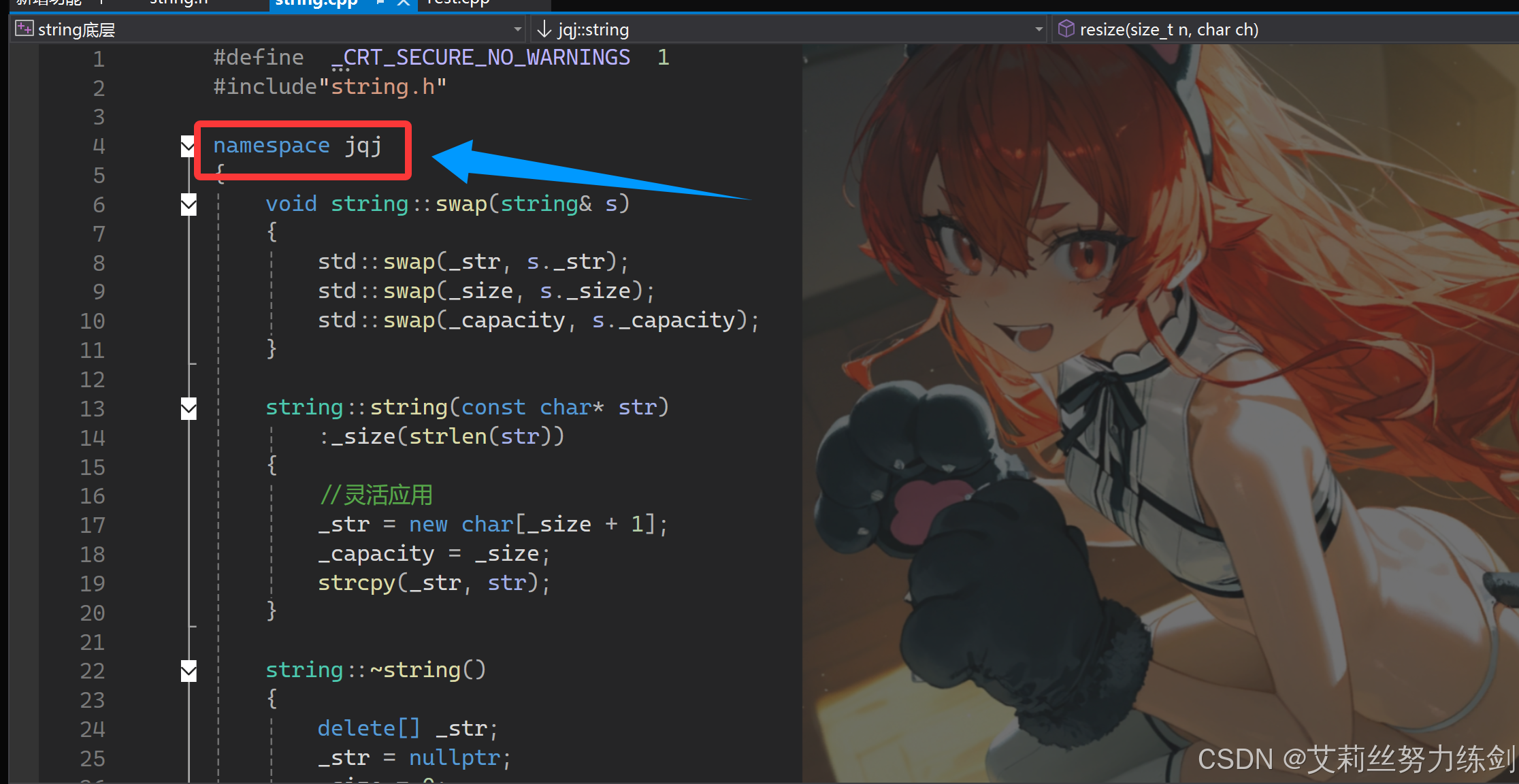
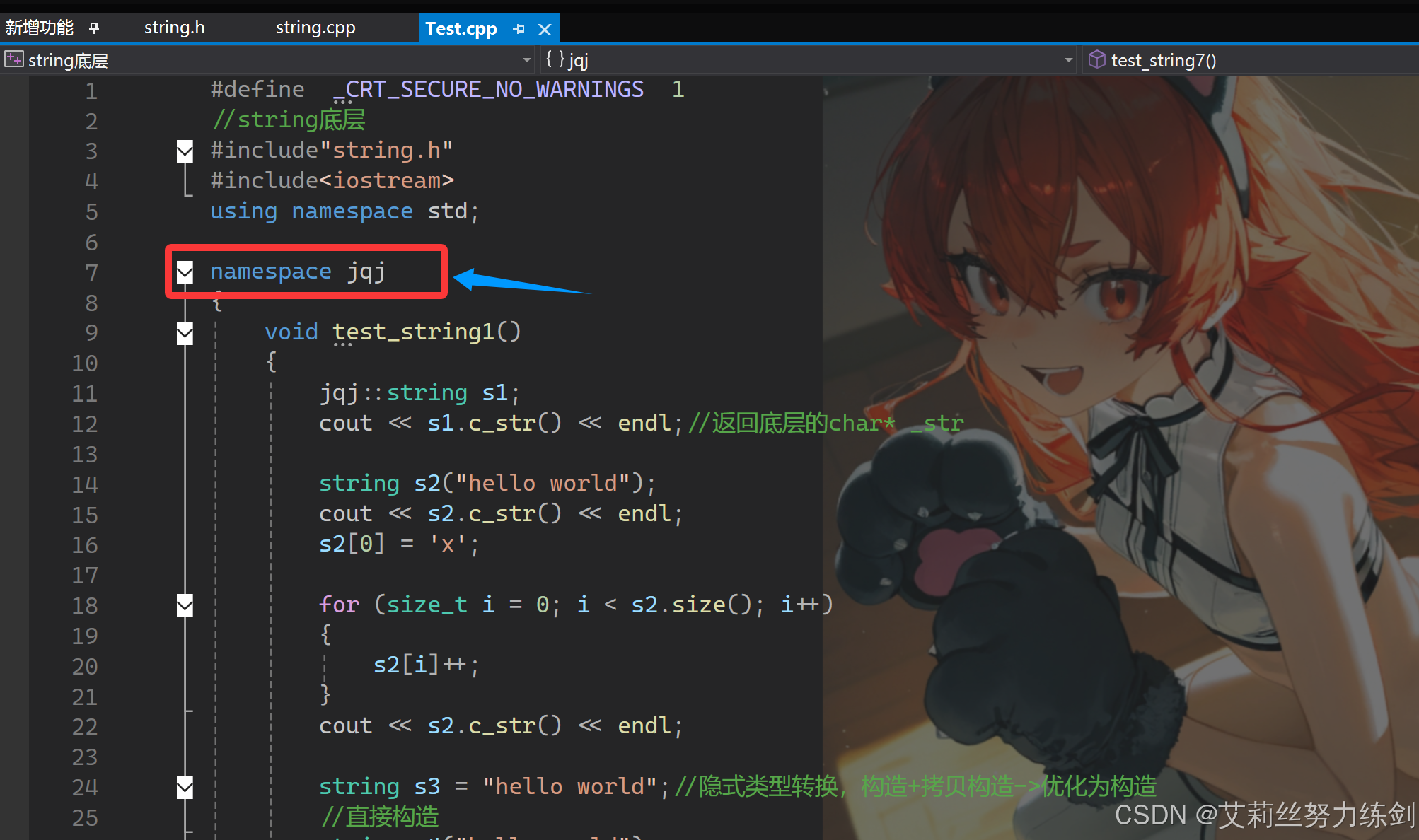
长一点的就声明和定义分离(.h、.cpp),声明定义缺省不能同时存在,而短一点的可以直接内联。这里的namespace命名空间就是直接让编译器认为三个文件是同一个文件。
4.3 为什么像operator+这类函数要重载到全局
不重载成成员函数,而是重载成全局函数,这样不同类型的字符就可以进行运算了。
4.4 比较大小

这段代码之前在实现Date类的时候就亮过相,可以“偷懒”,直接复用——
//比较大小
bool string::operator<(const string& s) const
{
return strcmp(_str, s._str) < 0;
}
bool string::operator<=(const string& s) const
{
return *this < s || *this == s;
}
bool string::operator>(const string& s) const
{
return !(*this <= s);
}
bool string::operator>=(const string& s) const
{
return !(*this < s);
}
bool string::operator==(const string& s) const
{
return strcmp(_str, s._str) == 0;
}
bool string::operator!=(const string& s) const
{
return !(*this == s);
}4.5 clear( )

void clear()//清理有效数据
{
_str[0] = '\0';//第一个变成\0
_size = 0;
//clear()非常简单
}4.6 string类的三个swap

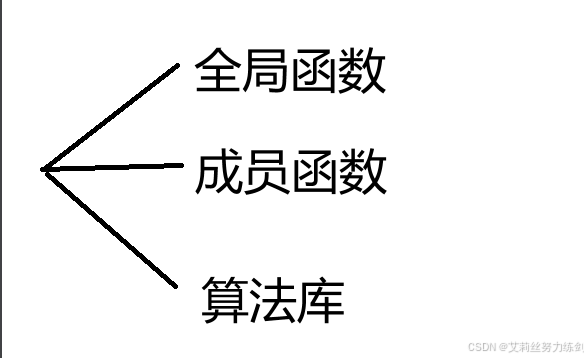
//string涉及到的swap有三个:
//成员函数、全局函数、算法库(C++98:针对string就不高效了,特点是通用)
void swap(string& s); void swap(T& a, T& b) //算法库里的swap交换算法
{
T c(a);
a = b;
b = c;
} inline void swap(string& a, string& b)
{
a.swap(b);
}4.7 operator+=
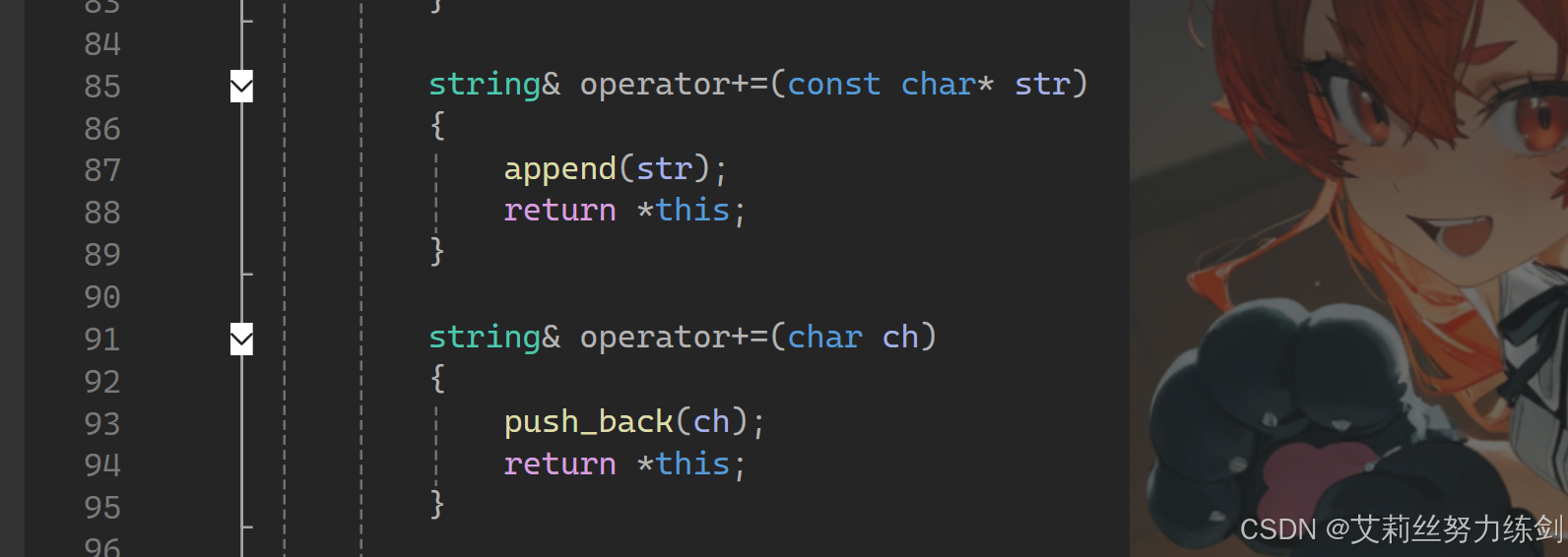
4.8 insert && erase && find && substr && push_back && append

4.8.1 insert
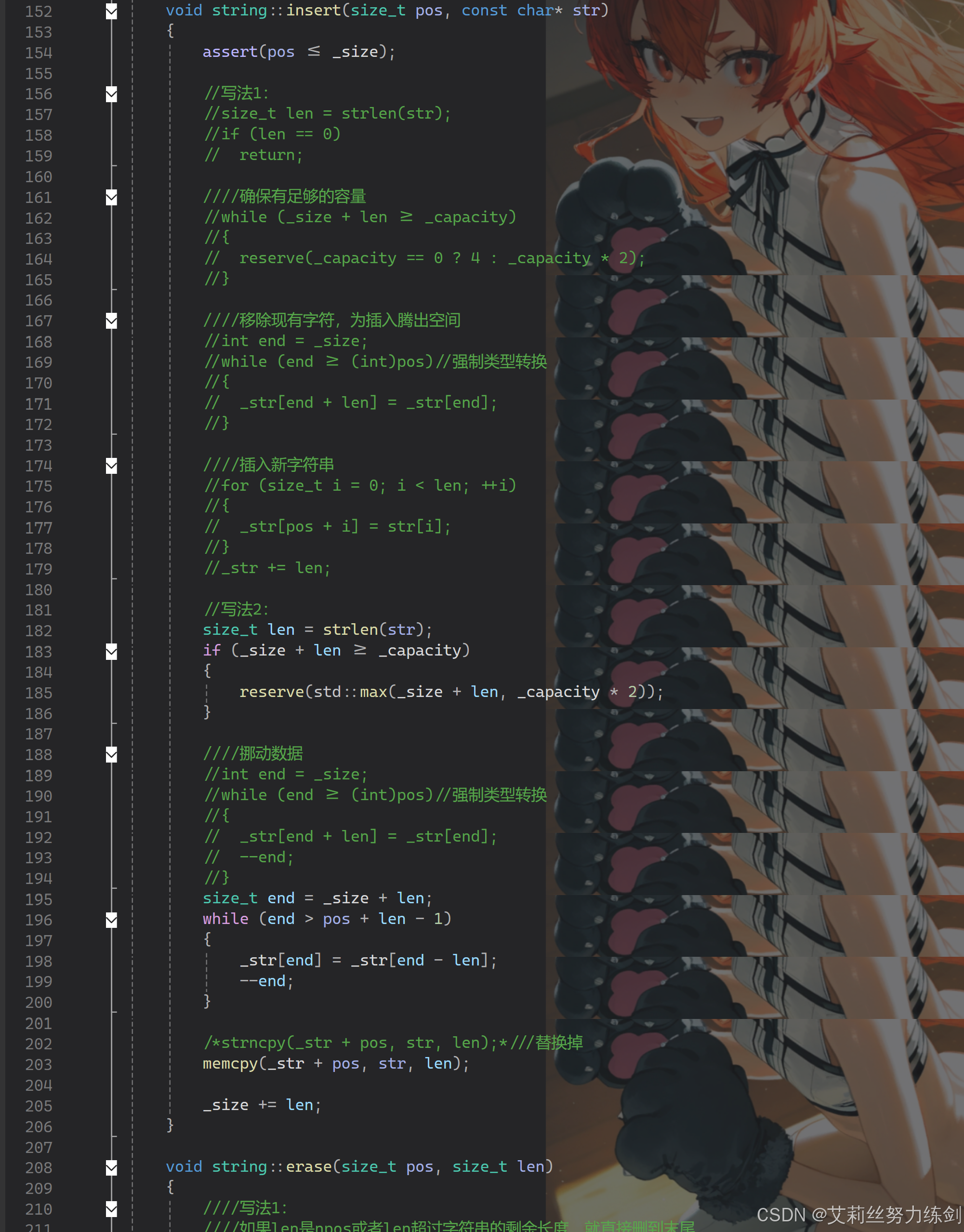
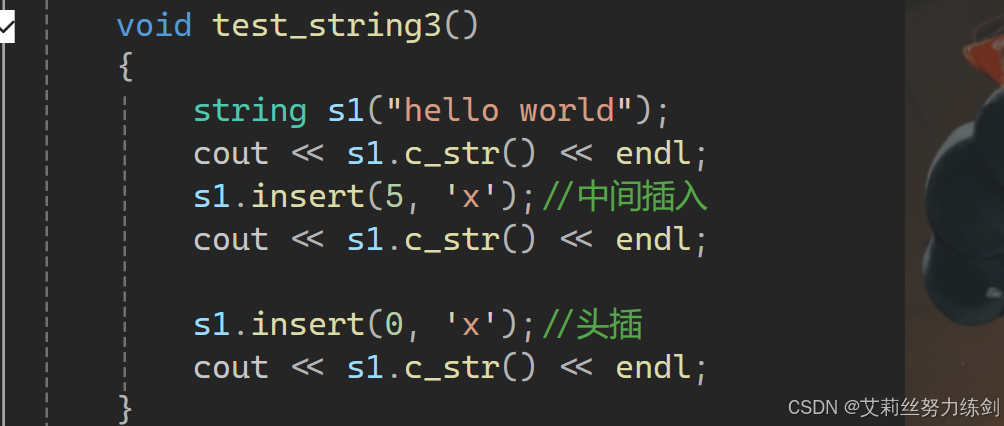

4.8.2 erase

4.8.3 find
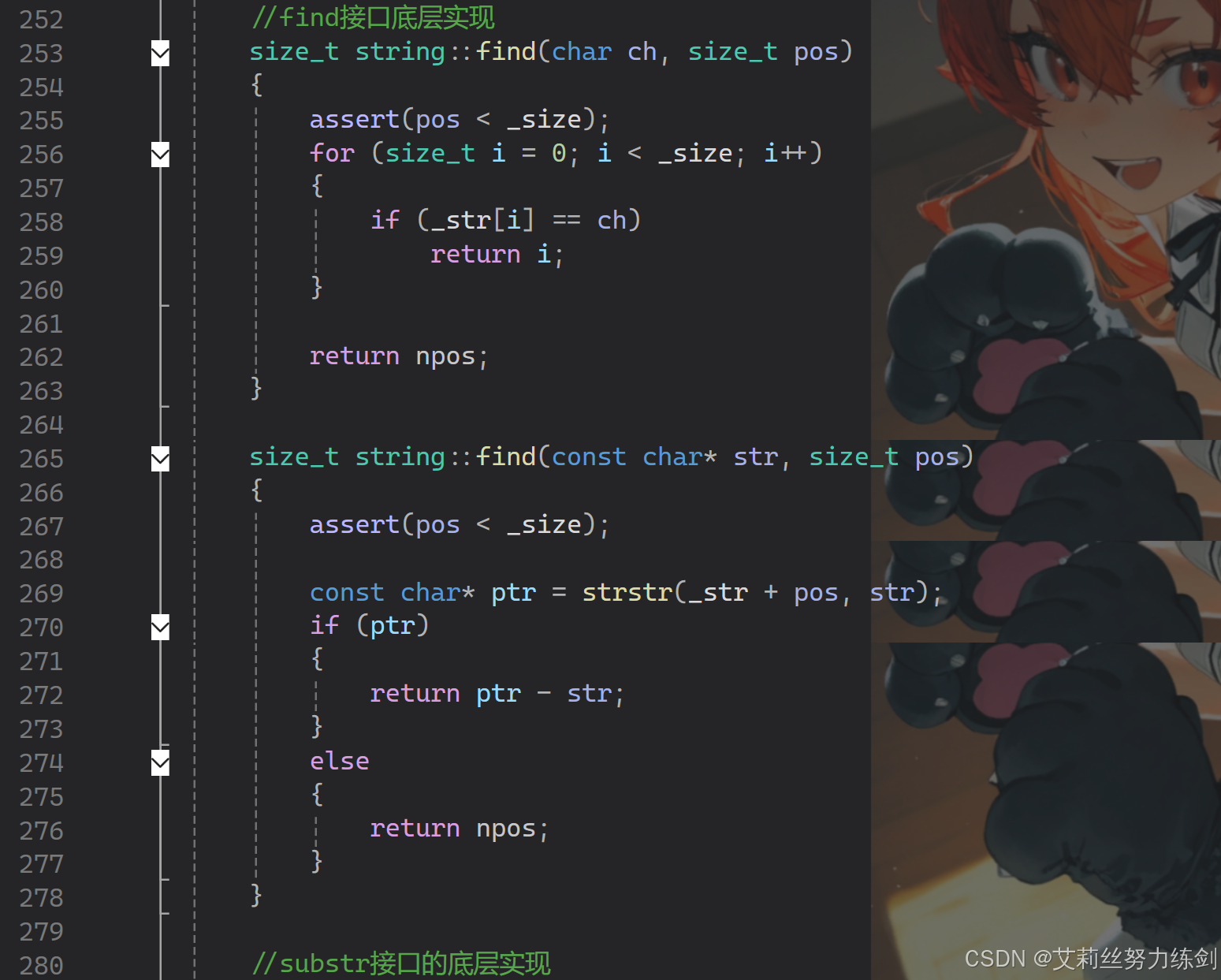
4.8.4 substr

4.8.5 push_back
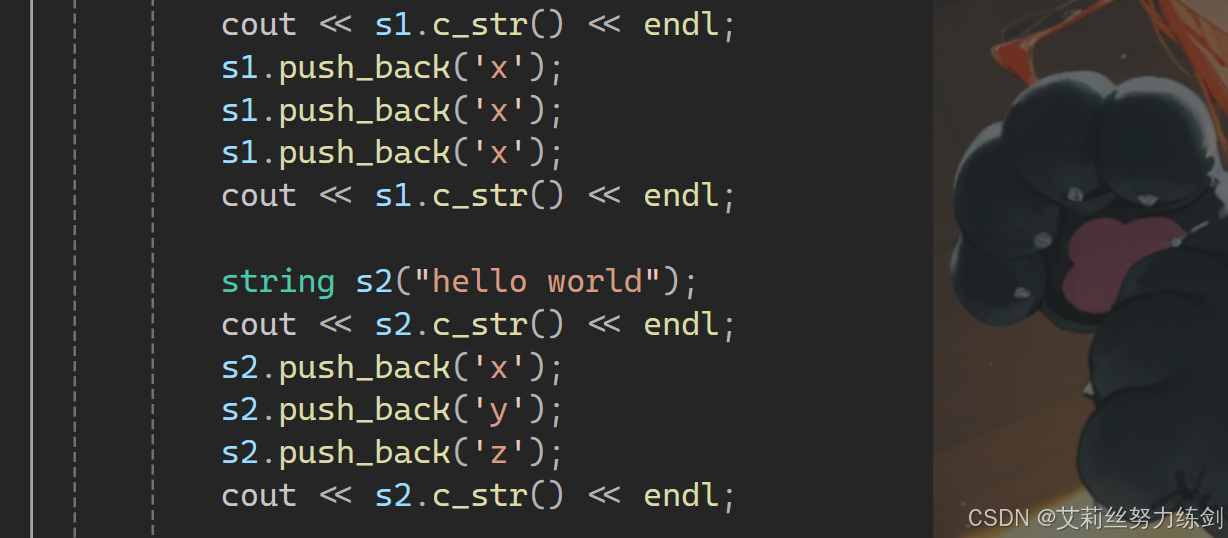
4.8.6 append


4.9 resize:修改数据

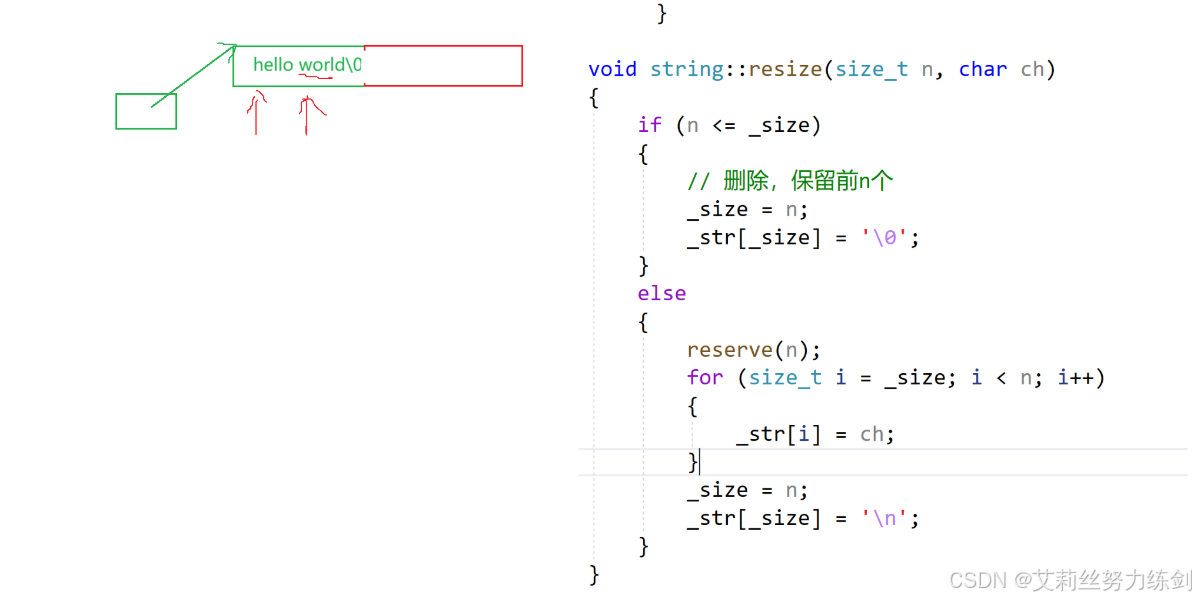
4.10 reserve:扩容
一般是扩容,之前介绍过,reserve在vs2022上面不会缩容。

4.11 为什么strcpy要改成memcpy || memmove?

用strcpy如果碰上中间多个\0就废了,由于C语言的兼容性,到\0就停止了,后面可能是几个随机值对应的汉字,像什么“烫烫烫”、“屯屯屯”、“蔼蔼碍”等等莫名其妙的汉字。
所以我们使用memcpy或者memmove,会把所有的\0存下来。
多个\0这种情况中,最后一个\0是标识符,前面的\0是字符。
因此,我们其他地方也都要改掉——
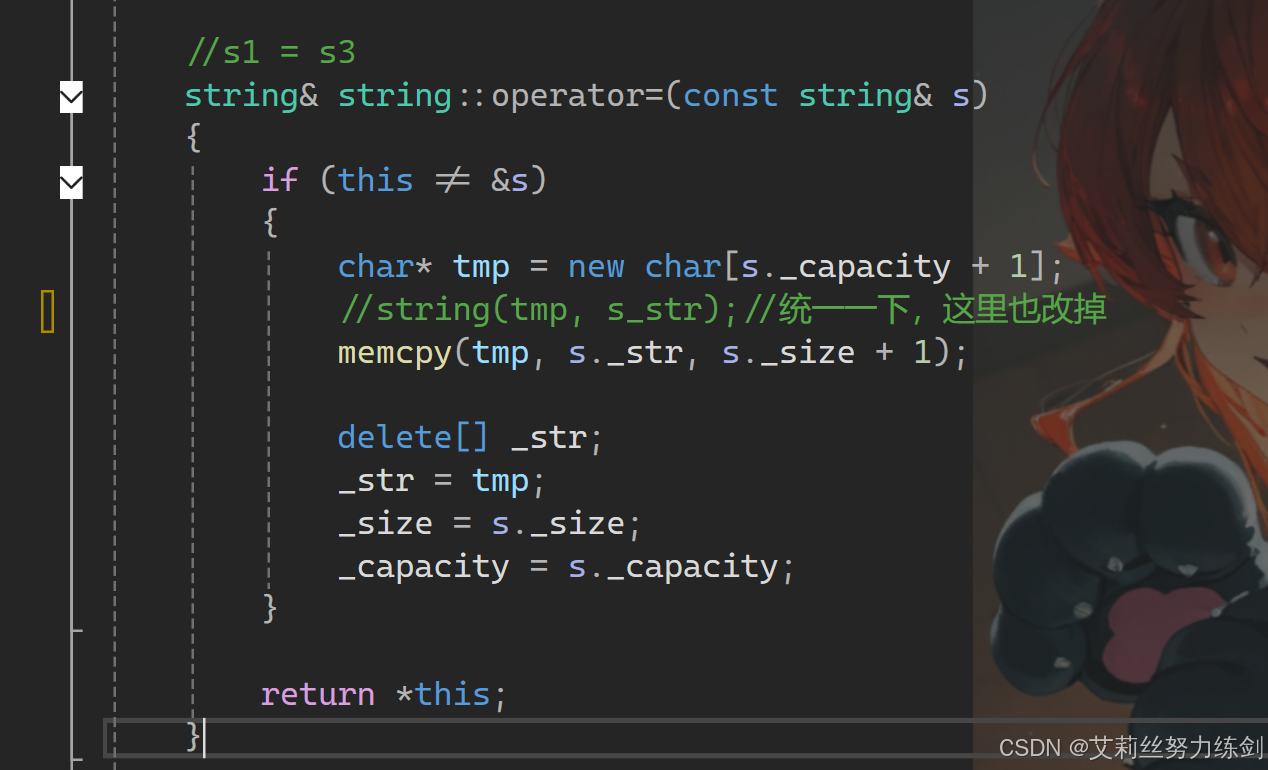
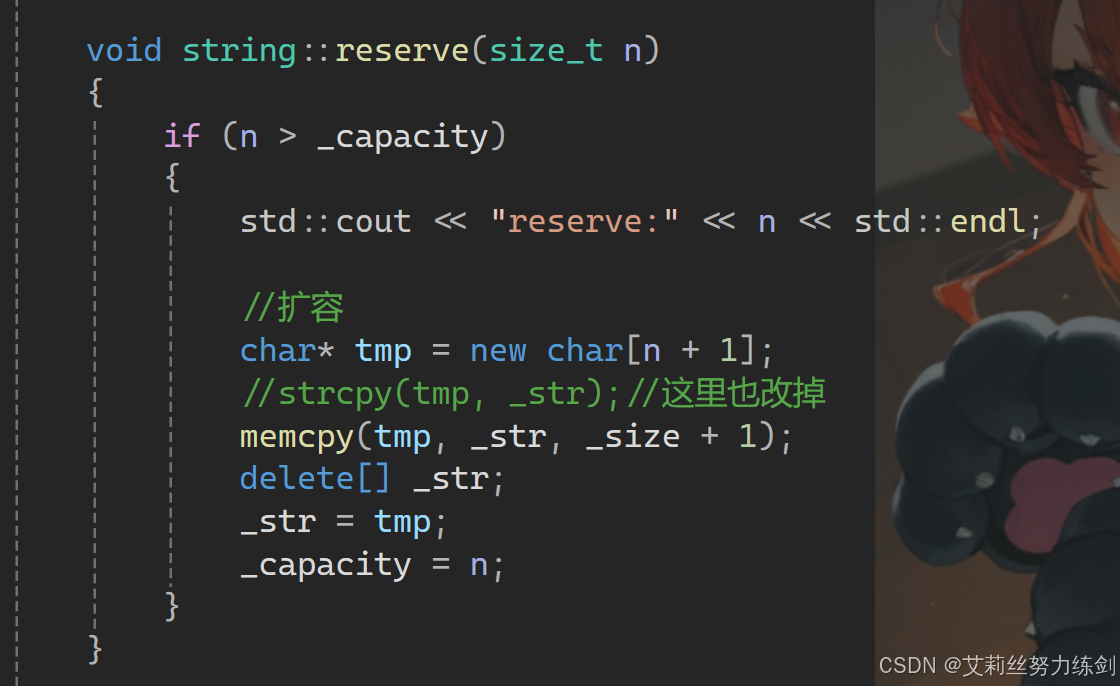

4.12 getline

4.13 挪动数据(示意图)
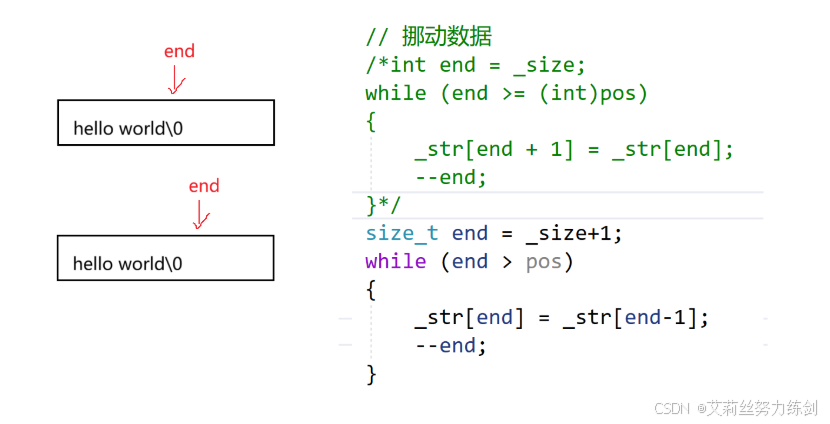
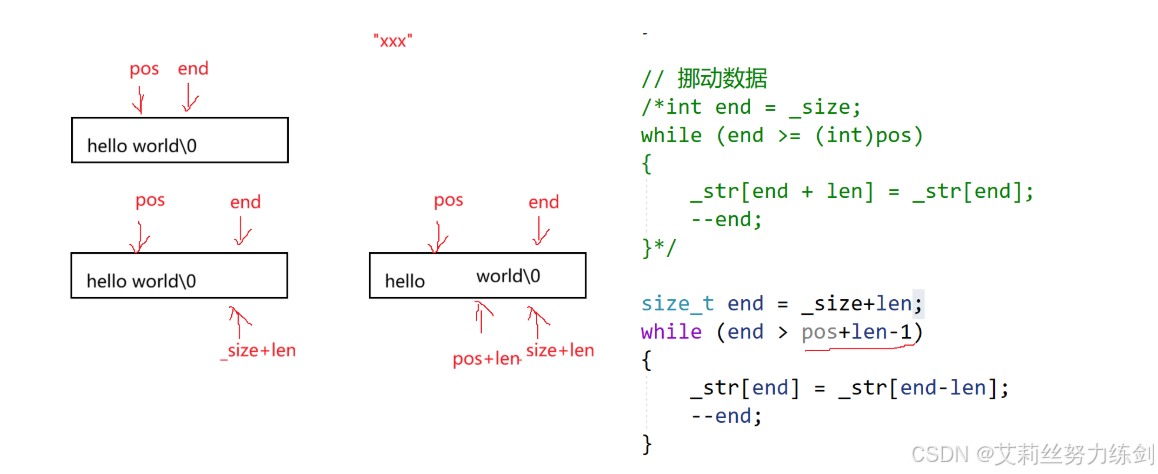

4.14 string s2(s1)
//string s2(s1);
string::string(const string& s)
{
_str = new char[s._capacity + 1];
/*strcpy(_str, s._str);*/
//用strcpy如果碰上中间多个\0就废了,C语言的兼容性,到\0就停止了,后面可能是随机数对应的汉字
memcpy(_str, s._str, s._size + 1);
//所以我们使用memcpy或者memmove,会把所有的\0存下来
//多个\0这种情况中,最后一个\0是标识符,前面的\0是字符
_size = s._size;
_capacity = s._capacity;
}
//s1 = s3
string& string::operator=(const string& s)
{
if (this != &s)
{
char* tmp = new char[s._capacity + 1];
//string(tmp, s_str);//统一一下,这里也改掉
memcpy(tmp, s._str, s._size + 1);
delete[] _str;
_str = tmp;
_size = s._size;
_capacity = s._capacity;
}
return *this;
}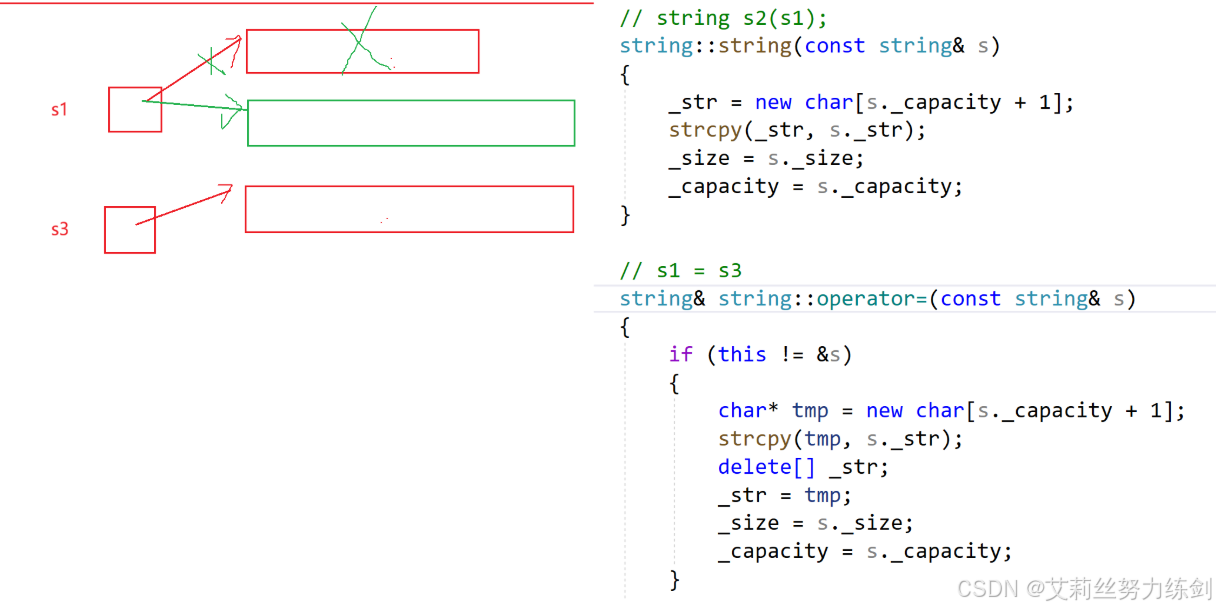
5 ~> String类的实现:深拷贝与浅拷贝的隐患与解决
5.1 引子
#define _CRT_SECURE_NO_WARNINGS 1
#include<iostream>
#include<string.h>
#include<assert.h>
// 为了和标准库区分,此处使用String
class String
{
public:
/*String()
:_str(new char[1])
{*_str = '\0';}
*/
//String(const char* str = "\0") 错误示范
//String(const char* str = nullptr) 错误示范
String(const char* str = "")
{
// 构造String类对象时,如果传递nullptr指针,可以认为程序非
if (nullptr == str)
{
assert(false);
return;
}
_str = new char[strlen(str) + 1];
strcpy(_str, str);
}
~String()
{
if (_str)
{
delete[] _str;
_str = nullptr;
}
}
private:
char* _str;
};
// 测试
void TestString()
{
String s1("hello world!!!");
String s2(s1);
}// 为了和标准库区分,此处使用String
class String
{
public:
/*String()
:_str(new char[1])
{*_str = '\0';}
*/
//String(const char* str = "\0") 错误示范
//String(const char* str = nullptr) 错误示范
String(const char* str = "")
{
// 构造String类对象时,如果传递nullptr指针,可以认为程序非
if (nullptr == str)
{
assert(false);
return;
}
_str = new char[strlen(str) + 1];
strcpy(_str, str);
}
~String()
{
if (_str)
{
delete[] _str;
_str = nullptr;
}
}
private:
char* _str;
};
// 测试一下
void TestString()
{
String s1("hello world!!!");
String s2(s1);
}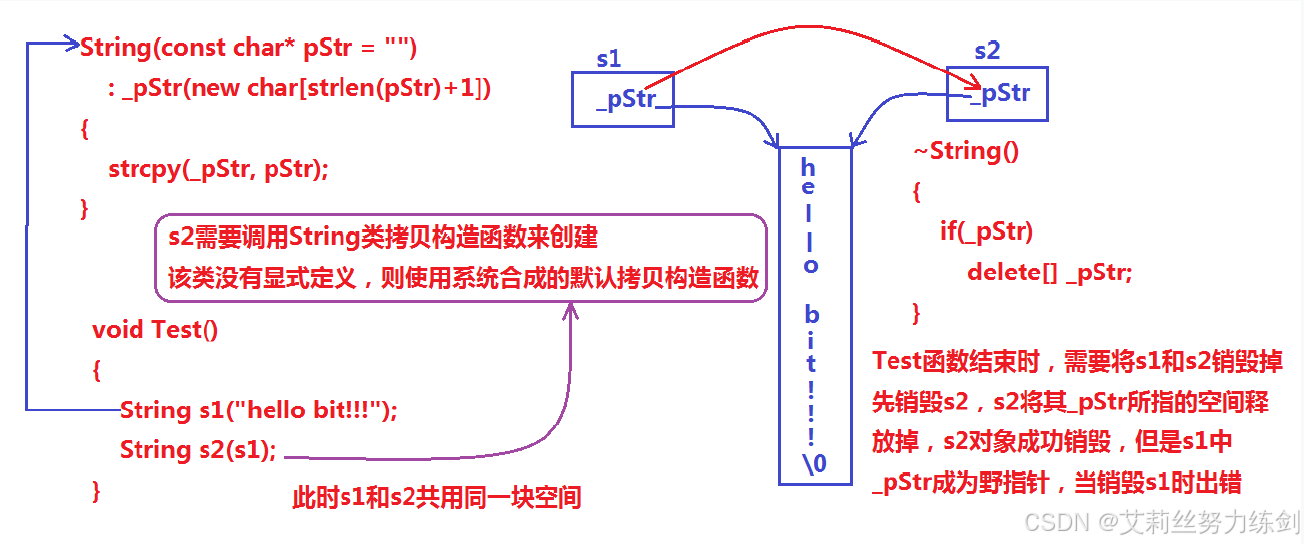
说明:上述String类没有显式定义其拷贝构造函数与赋值运算符重载,此时编译器会合成默认的,当用s1构造s2时,编译器会调用默认的拷贝构造。最终导致的问题是,s1、s2共用同一块内存空间,在释放时同一块空间被释放多次而引起程序崩溃,这种拷贝方式,就称为浅拷贝。
5.2 浅拷贝
浅拷贝:也称位拷贝,编译器只是将对象中的值拷贝过来。如果对象中管理资源,最后就会导致多个对象共享同一份资源,当一个对象销毁时就会将该资源释放掉,而此时另一些对象不知道该资源已经被释放,以为还有效,所以当继续对资源进项操作时,就会发生发生了访问违规。

举个例子,就像一个家庭中有两个孩子,但父母只买了一份玩具,两个孩子愿意一块玩,则万事大吉,万一这两个孩子不想分享,就你争我夺,玩具损坏——世子之争,向来如此。
可以采用深拷贝解决浅拷贝问题,即:每个对象都有一份独立的资源,不要和其他对象共享。父母给每个孩子都买一份玩具,各自玩各自的就不会有问题了。

5.3 深拷贝
如果一个类中涉及到资源的管理,其拷贝构造函数、赋值运算符重载以及析构函数必须得要显式给出。一般情况都是按照深拷贝方式提供。

5.3.1 传统写法的string类

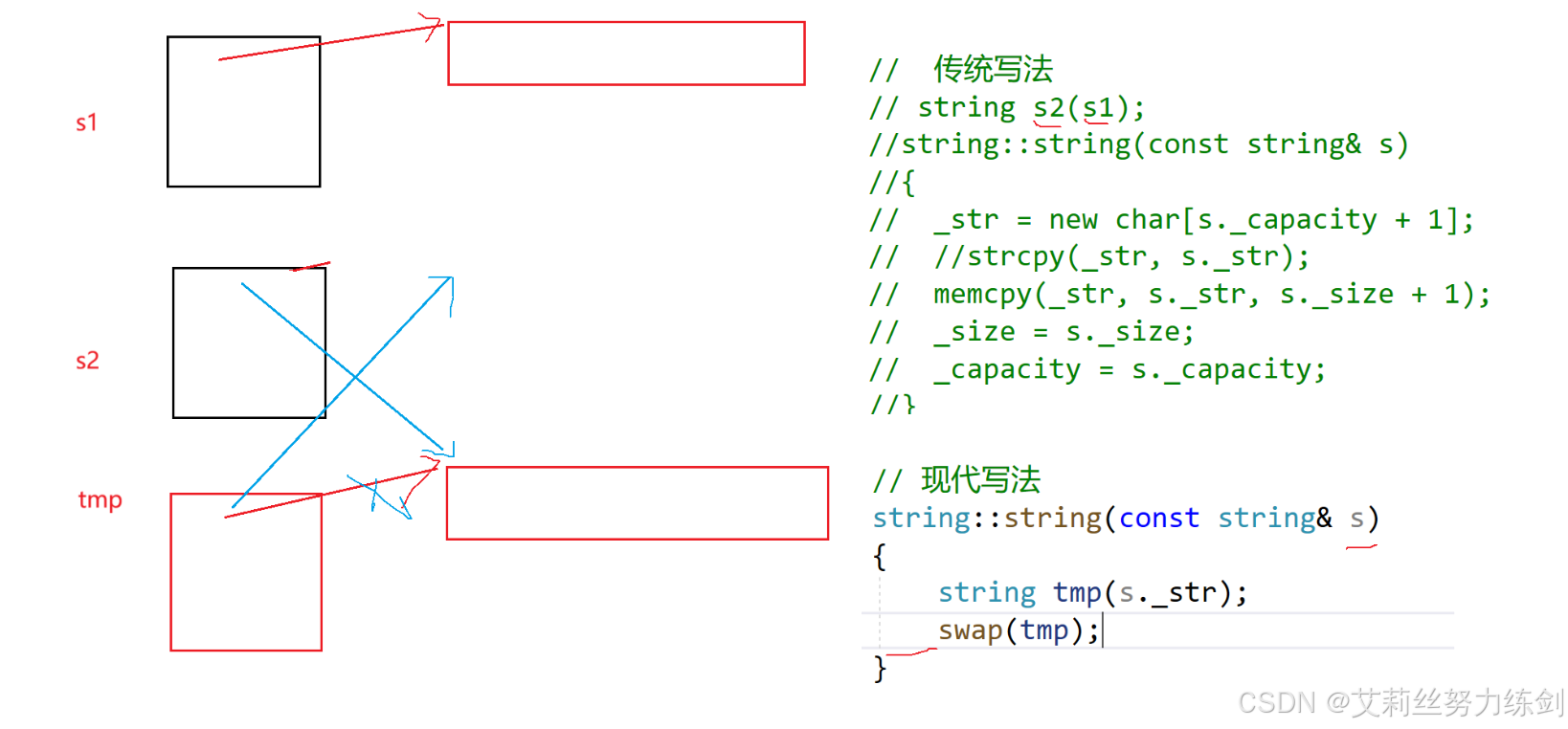
5.3.2 现代版写法的string类
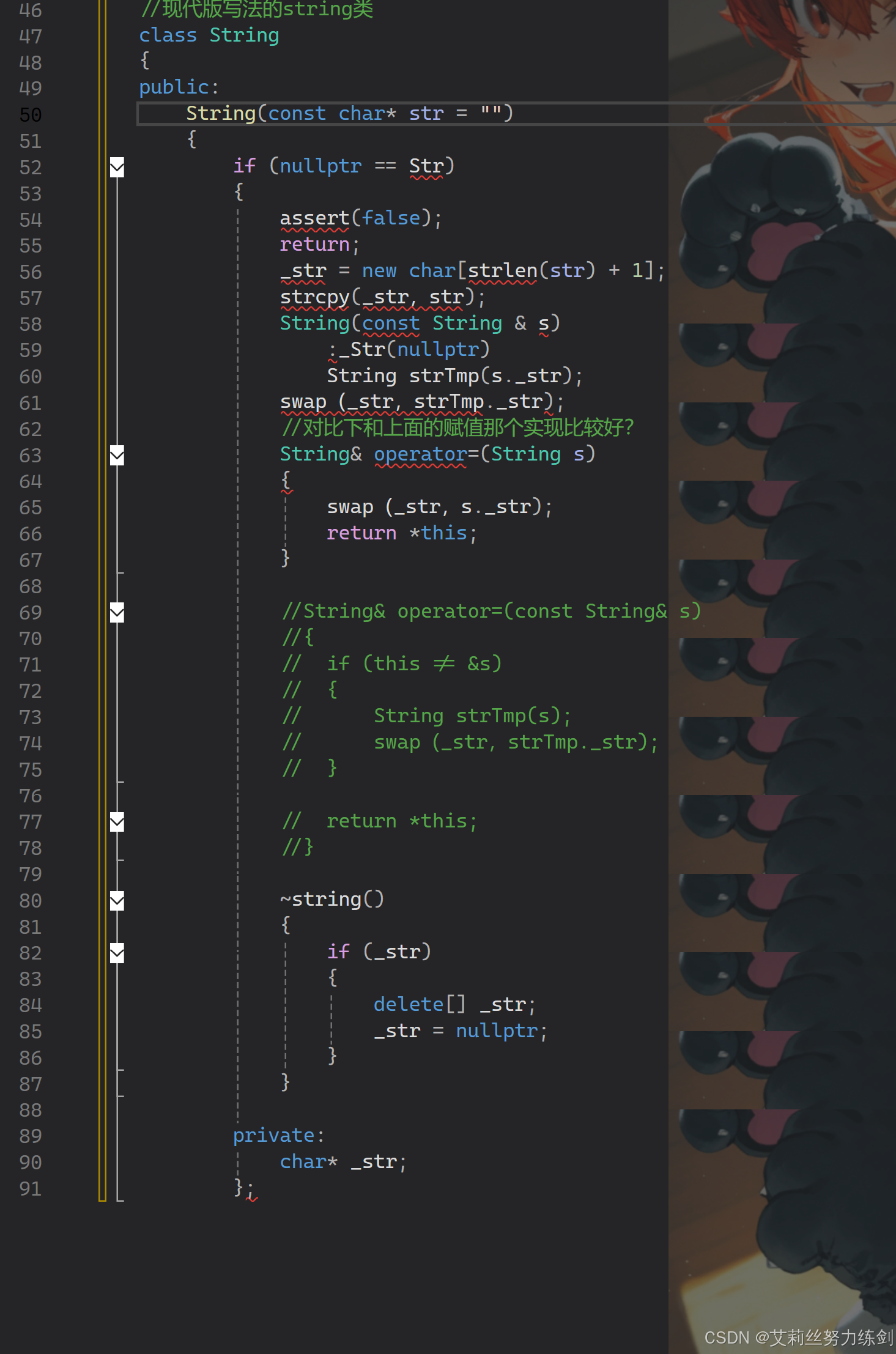
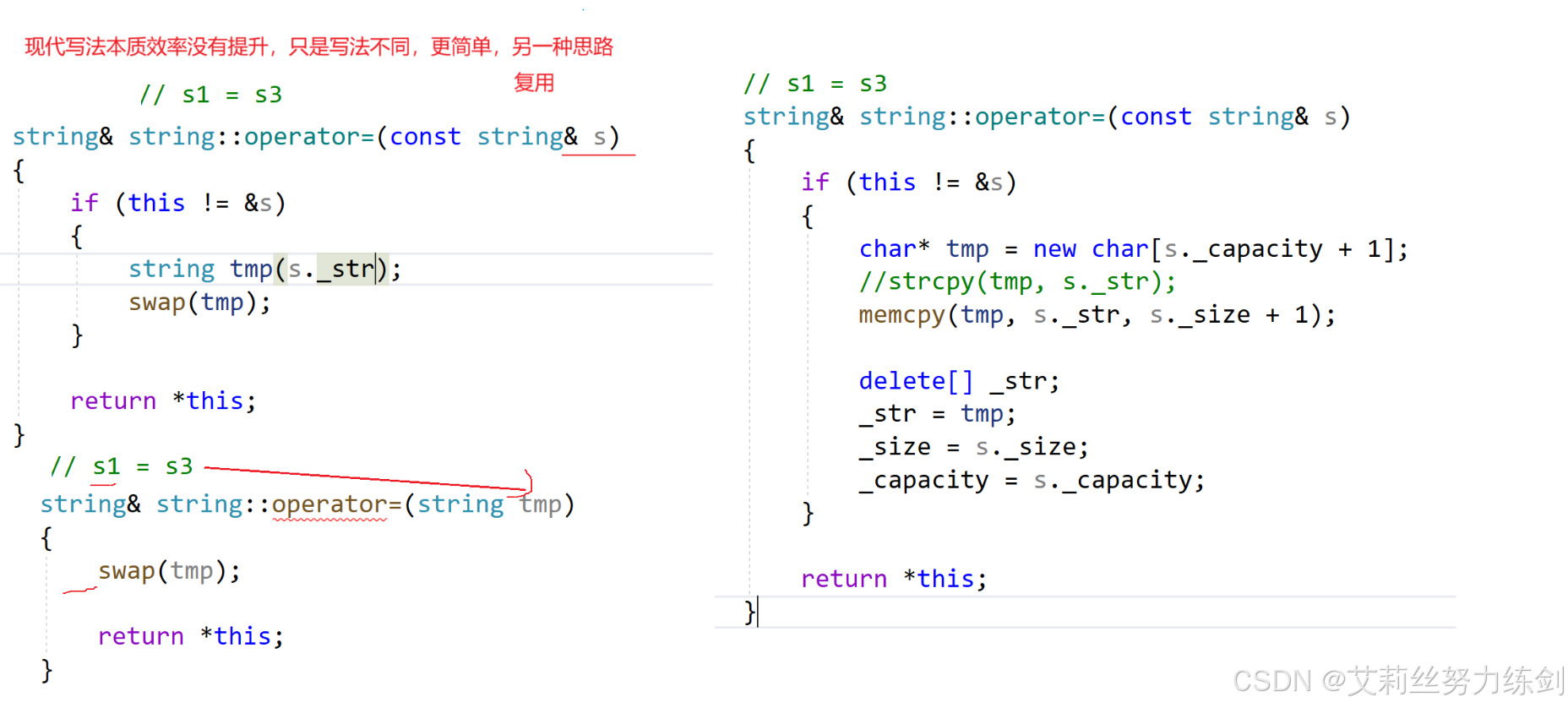
5.3.3 SBO && 小buffer优化
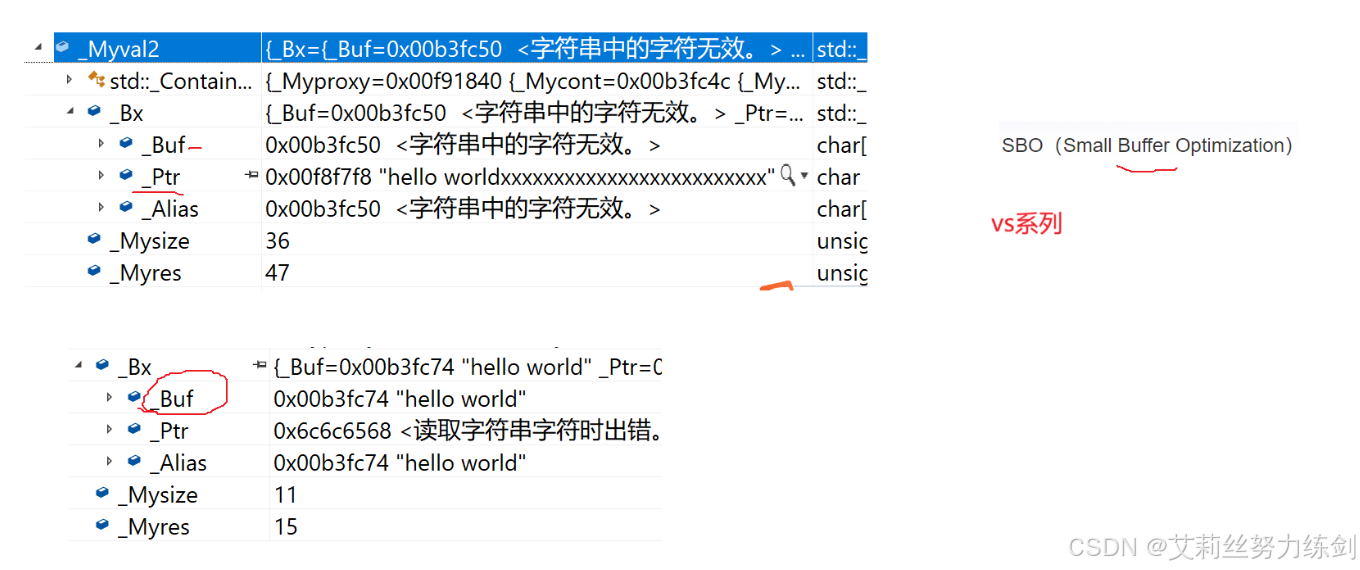
5.4 写时拷贝

写时拷贝就是一种拖延症,是在浅拷贝的基础之上增加了引用计数的方式来实现的。
引用计数:用来记录资源使用者的个数。在构造时,将资源的计数给成1,每增加一个对象使用该资源,就给计数增加1,当某个对象被销毁时,先给该计数减1,然后再检查是否需要释放资源,如果计数为1,说明该对象时资源的最后一个使用者,将该资源释放;否则就不能释放,因为还有其他对象在使用该资源。
5.4.1 引用计数写时拷贝

5.4.2 向大佬学习
我们来看一位已故大佬陈皓的文章,介绍得很详尽——
陈皓大佬的博客个人主页链接:陈皓(左耳朵耗子)
5.4.3 扩展阅读
6 ~> 本文完整代码
1 使用层面剩余代码实现
Test.cpp:
#define _CRT_SECURE_NO_WARNINGS 1
#include<iostream>
#include<string>
#include<algorithm>
#include<list>
using namespace std;
//int main()
//{
// ////send:网络的接口,给别人发送东西要调用
// //string str("hello world");
// //send(str.c_str());//c_str,最核心的就是如果是C语言风格的接口,就能很好的兼容
//
// string filename("Test.cpp");
// FILE* fout = fopen(filename.c_str(), "r");
// if (fout)
// {
// cout << "打开文件成功" << endl;
// }
// //一般用c_str就不太用data了
// //get_allocator:可以获取内部用的内存池,allocator就是内部的内存池对象
// //allocator<T>给的是缺省参数,可以自己写一个申请内存释放内存的内存池,传过去的就是你的了
// //——给你一个空间,让你可以选择用别人写的,也可以说觉得别人写得不行,用你自己的
//
// //std::string::copy —— 从pos开始的len个的字符拷贝出来到一个char*指向的数组什么什么的——我们一般不用这个接口
// //我们一般用string::substr——这个很好用——拷贝从pos位置开始的len个字符这样一部分,构造一个string对象返回
//
// //string suffix = filename.substr(4, 4);
// //不用给第二个缺省参数,默认取到结尾
//
// //string suffix = filename.substr(4);
// //cout << suffix << endl;
// //由此可见这个substr比copy好用多了,我们就不用这个copy
//
// //万一给了这样一个文件
// //string filename("Testabxxxx.cpp");
// //FILE* fout = fopen(filename.c_str(), "r");
// //if (fout)
// //{
// // cout << "打开文件成功" << endl;
// //}
// //查找
// //size_t pos = filename.find('.');//没找到返回npos
// //if (pos != string::npos)
// //{
// // string suffix = filename.substr(4);
// // cout << suffix << endl;
// //}
//
// //比如说给了个Test.c
// //string file("Test.c");
// //size_t pos = file.find('.');
// //if (pos != string::npos)
// //{
// // string suffix = file.substr(4);
// // cout << suffix << endl;
// //}
//
// //比如说给了个多个后缀名,如Test.tar.zip这样的——那我们就倒着找:rfind(倒着往前找)
// string file("Test.tar.zip");
// //如果只想找.zip
// size_t pos = file.rfind('.');//没找到也是返回npos
// if (pos != string::npos)
// {
// string suffix = file.substr(pos);
// cout << suffix << endl;
// }
//
// //找个现实当中样例更复杂一点的,比如说URL—— 一个网址 —— 网络里面会接触
// string url = "https://legacy.cplusplus.com/reference/string/string/rfind/";
// //协议:https;域名:legacy.cplusplus.com;域名之下的内容:reference/string/string/rfind/
// //协议/域名(要发向的网址的服务器地址是什么,通过协议转换为IP)/内容
// //http和https的区别:https是加密过的,更加安全
// size_t i1 = url.find(":") ;//假设第一个位置叫i1,i1指向“:”
// //取到这个网络(network)协议(protocol)的子串
// if (i1 != string::npos)
// {
// string protocol = url.substr(0, i1);//左闭右开,直接减——开区间位置减去闭区间位置就是个数
// //用substr空间它底层会自己管理,copy这里有个char*指针,用多少空间还得自己算,substr自己会管理空间何乐而不为?
// // 所以说copy不好用,我们一般不会去用
// cout << protocol << endl;//获取到协议的名称:https
// //假设要找域名,“/”不好找,但是所有的协议有一个特点:格式是定死的——协议后面是“:”,“:”后面是两个“/”
////find可以指定从pos位置开始找,我们就指定在两个“/”后面开始找,找此时后面第一个“/”,即从i1+3位置(://)开始找
// size_t i2 = url.find('/', i1 + 3);
// if (i2 != string::npos)
// {
// //取出域名
// string domain = url.substr(i1 + 3, i2 - (i1 + 3));
// cout << domain << endl;//domain:域名
//
// //取出第三部分:一般称之为“资源”——了解了网络就知道了
// string uri = url.substr(i2 + 1);//没必要算结尾的位置了,直接substr
// cout << uri << endl;
//
// //通过find、rfind、substr配合,就可以把协议的经典的三个部分分隔开,并且取出来
// //可见在实践中在分割字符串等方面还是非常有用的
// }
// }
////下面这四个(【string operations】的)接口了解一下即可,基本上用不到
////find_first_of
//// 只要是源字符串里面有任意一个find_first_of子串里面的字符,就都返回
//// 都比对一遍,是子串里面的就要修改成'*',不是就不动,返回的时候在子串里面的就修改成'*'了
//// 不是取到第一个,实际上这个接口的表述有问题,应该叫find_any_of才比较恰当
//// 为什么不改?语言的向前兼容问题——已经发布好几年了,不敢轻易改动。这个接口用得不多
////find_last_of
//// 和find_first_of的区别就是它是倒着往前找的,实际上应该叫rfind_first_of才对
////find_first_not_of
//// 比如"abcdefasfgsa"这样一个字符串返回,比如说要找abcde就只保留abcde,其余修改
//// 也就是说给一个子串,和源串对比,是就保留,不是就修改
////find_last_not_of
// //正好和find_first_not_of反过来
// std::string str("Please,replace the vowels in this sentence by asterisks.");
// std::size_t found = str.find_first_not_of("aeiou");
// while (found != std::string::npos)
// {
// str[found] = '*';
// found = str.find_first_not_of("aeiou", found + 1);
// }
//
// std::cout << str << '\n';
// //运算符重载用起来香
// //cout << str < url << endl;//运算符优先级的问题,会先比较左边
// cout << (str < url) << endl;//按字典——ASCII码表比较
// //这里从小写的h和大写的P开始比较(h大,大写在前,小写在后)
// //比较ASCII码值,字符没办法字符是无法存储的,字符底层是查ASCII码表,看字符映射的整型值,即字符的ASCII码值
//
// //不重载成成员函数而重载成全局的目的就是:这样不同类型之间也可以比较:string可以和const char*比较
//
// //compare和npos都不看了
//
// //operator+是以非成员函数重载的:
// //operator+和operator+=的区别就是:“+”不改变自己,“+=”要改变自己
// //成员函数实现不了:传参第一个一定是str
// cout << str + "xxxxx" << endl;
// cout << str + url << endl;
// cout << "xxxxx" + str + url << endl;
// //当心:传值返回 —— 代价要大一些,返回的是传值对象的拷贝。
// // 现在的编译器不用担心,C++11之后编译器有优化,效率很高
//
// //C++11以后,传值返回对象效率都很不错
// string ret = str + "xxxxxx";//引用
//
// //流插入、流提取:operator>>(cin)、operator<<(cout)
// //注意:输入多个字符串,默认是" "或者endl/'\n'换行去间隔
// cin >> url >> str;
// cout << url << endl;
// cout << str << endl;
// //遇到空格或者换行,编译器就认为这一次的输入就结束了
// //输入xxxx yyyy,xxxx就进入到url里面,yyyy就进入到str里面
// //getline,换行不结束,甚至可以自己控制什么时候结束
//
// //swap:这个阶段不结合底层讲不清楚
//
// return 0;
//}2 string类底层实现
string.h:
#pragma once
#include<iostream>
#include<string.h>
#include<assert.h>
#include<algorithm>
//命名空间
namespace jqj
{
//类
class string
{
public:
//string()
// :_str(new char[1] {'\0'})
// , _size(0)
// , capacity(0)
//{}
typedef char* iterator;
typedef const char* const_iterator;
iterator begin()
{
return _str;
}
iterator end()
{
return _str + _size;
}
const_iterator begin() const
{
return _str;
}
const_iterator end() const
{
return _str + _size;
}
char& operator[](size_t pos)
{
assert(pos < _size);
return _str[pos];
}
const char& operator[](size_t pos) const
{
assert(pos < _size);
return _str[pos];
}
size_t size() const
{
return _size;
}
const char* c_str() const
{
return _str;
}
//string涉及到的swap有三个:成员函数、全局函数、算法库(C++98:针对string就不高效了,特点是通用)
void swap(string& s);
string(const char* str = "");
~string();
string(const string& s);
string& operator=(const string& s);
void resize(size_t n, char ch = '\0');//改变数据
void reserve(size_t n);
void push_back(char ch);
void append(const char* str);
void clear()//清理有效数据
{
_str[0] = '\0';//第一个变成\0
_size = 0;
//clear()非常简单
}
string& operator+=(const char* str)
{
append(str);
return *this;
}
string& operator+=(char ch)
{
push_back(ch);
return *this;
}
void insert(size_t pos, char ch);
void insert(size_t pos, const char* ch);
void erase(size_t pos = 0, size_t len = npos);
size_t find(char ch, size_t pos = 0);
size_t find(const char* str, size_t pos = 0);
string substr(size_t pos = 0, size_t len = npos);
//有了substr没必要算结尾的位置了,直接substr到结尾
//这段代码之前在实现Date类的时候就亮过相,可以“偷懒”,直接复用
bool operator<(const string& s) const;
bool operator<=(const string& s) const;
bool operator>(const string& s) const;
bool operator>=(const string& s) const;
bool operator==(const string& s) const;
bool operator!=(const string& s) const;
private:
char* _str;
size_t _size;
size_t _capacity;
public:
// const static整型可以这么用,进行特殊处理 —— 这里是编译器针对整型的一个特殊处理
const static size_t npos = -1;
//为什么说是针对整型?如下,浮点数就不能用——
//double不支持
//const static double x = 1.1;
};
//流插入(istream)和流提取(ostream)
std::ostream& operator<<(std::ostream& out, const string& s);
std::istream& operator>>(std::istream& in, string& s);
std::istream& getline(std::istream& in, string& s,char delim = '\n');
template<class T>//模版
//swap(string涉及到三种swap)
void swap(T& a, T& b) //算法库里的swap交换算法
{
T c(a);
a = b;
b = c;
}
inline void swap(string& a, string& b)
{
a.swap(b);
}
}string.cpp:
#define _CRT_SECURE_NO_WARNINGS 1
#include"string.h"
namespace jqj
{
void string::swap(string& s)
{
std::swap(_str, s._str);
std::swap(_size, s._size);
std::swap(_capacity, s._capacity);
}
string::string(const char* str)
:_size(strlen(str))
{
//灵活应用
_str = new char[_size + 1];
_capacity = _size;
strcpy(_str, str);
}
string::~string()
{
delete[] _str;
_str = nullptr;
_size = 0;
_capacity = 0;
}
//string s2(s1);
string::string(const string& s)
{
_str = new char[s._capacity + 1];
/*strcpy(_str, s._str);*/
//用strcpy如果碰上中间多个\0就废了,C语言的兼容性,到\0就停止了,后面可能是随机数对应的汉字
memcpy(_str, s._str, s._size + 1);//所以我们使用memcpy或者memmove,会把所有的\0存下来
//多个\0这种情况中,最后一个\0是标识符,前面的\0是字符
_size = s._size;
_capacity = s._capacity;
}
//s1 = s3
string& string::operator=(const string& s)
{
if (this != &s)
{
char* tmp = new char[s._capacity + 1];
//string(tmp, s_str);//统一一下,这里也改掉
memcpy(tmp, s._str, s._size + 1);
delete[] _str;
_str = tmp;
_size = s._size;
_capacity = s._capacity;
}
return *this;
}
void string::reserve(size_t n)
{
if (n > _capacity)
{
std::cout << "reserve:" << n << std::endl;
//扩容
char* tmp = new char[n + 1];
//strcpy(tmp, _str);//这里也改掉
memcpy(tmp, _str, _size + 1);
delete[] _str;
_str = tmp;
_capacity = n;
}
}
//resize:修改数据
void string::resize(size_t n, char ch)
{
if (n <= _size)
{
//删除,保留前n个
_size = n;
_str[_size] = '\0';
}
else
{
reserve(n);
for (size_t i = 0; i < n; i++)
{
_str[i] = ch;
}
_size = n;
_str[_size] = '\0';
}
}
void string::push_back(char ch)
{
if (_size == _capacity)
{
reserve(_capacity == 0 ? 4 : _capacity * 2);
}
_str[_size] = ch;
_size++;
_str[_size] = '\0';
}
void string::append(const char* str)
{
size_t len = strlen(str);
if (_size + len > _capacity)
{
reserve(std::max(_size + len, _capacity * 2));
}
//strcpy(_str + _size, str);//改成memcpy
memcpy(_str + _size, str, len + 1);
_size += len;
}
void string::insert(size_t pos, char ch)
{
assert(pos <= _size);
if (_size == _capacity)
{
reserve(_capacity == 0 ? 4 : _capacity * 2);
}
//挪动数据
//int end = _size;
//while (end >= (int)pos)//强制类型转换
//{
// _str[end + 1] = _str[end];
// --end;
//}
//_str[pos] = ch;
//_size++;
//另一种写法,不用强制类型转换,指向原来end的后一个位置
size_t end = _size + 1;
while (end > pos)
{
_str[end] = _str[end - 1];
--end;
}
_str[pos] = ch;
_size++;
}
void string::insert(size_t pos, const char* str)
{
assert(pos <= _size);
//写法1:
//size_t len = strlen(str);
//if (len == 0)
// return;
////确保有足够的容量
//while (_size + len >= _capacity)
//{
// reserve(_capacity == 0 ? 4 : _capacity * 2);
//}
////移除现有字符,为插入腾出空间
//int end = _size;
//while (end >= (int)pos)//强制类型转换
//{
// _str[end + len] = _str[end];
//}
////插入新字符串
//for (size_t i = 0; i < len; ++i)
//{
// _str[pos + i] = str[i];
//}
//_str += len;
//写法2:
size_t len = strlen(str);
if (_size + len >= _capacity)
{
reserve(std::max(_size + len, _capacity * 2));
}
////挪动数据
//int end = _size;
//while (end >= (int)pos)//强制类型转换
//{
// _str[end + len] = _str[end];
// --end;
//}
size_t end = _size + len;
while (end > pos + len - 1)
{
_str[end] = _str[end - len];
--end;
}
/*strncpy(_str + pos, str, len);*///替换掉
memcpy(_str + pos, str, len);
_size += len;
}
void string::erase(size_t pos, size_t len)
{
////写法1:
////如果len是npos或者len超过字符串的剩余长度,就直接删到末尾
////删完了
//if (len == npos || pos + len >= _size)
//{
// _size = pos;
//}
//else
//{
// //移动字符,覆盖要删除的部分
// //删除部分
// size_t tmp = pos + len;
// while (tmp <= _size)
// {
// _str[pos + (tmp - (pos + len))] = _str[tmp];
// ++tmp;
// }
// _size -= len;
//}
//_str[_size] = '\0';
//写法2:
assert(pos < _size);
if (len == npos || len >= _size - pos)
{
//删完了
_size = pos;
_str[_size] = '\0';
}
else
{
//删除部分
/*strcpy(_str + pos, _str + pos + len);*/
memcpy(_str + pos, _str + pos + len, _size - (pos + len) + 1);
_size -= len;
}
}
//const size_t string::npos = -1;//声明定义分离,缺省参数不能声明和定义同时给
//find接口底层实现
size_t string::find(char ch, size_t pos)
{
assert(pos < _size);
for (size_t i = 0; i < _size; i++)
{
if (_str[i] == ch)
return i;
}
return npos;
}
size_t string::find(const char* str, size_t pos)
{
assert(pos < _size);
const char* ptr = strstr(_str + pos, str);
if (ptr)
{
return ptr - str;
}
else
{
return npos;
}
}
//substr接口的底层实现
string string::substr(size_t pos, size_t len)
{
assert(pos < _size);
if (len == npos || len > _size - pos)
{
len = _size - pos;
}
string sub;
sub.reserve(len);
for (size_t i = 0; i < len; i++)
{
sub += _str[pos + i];
}
return sub;
}
//比较大小
bool string::operator<(const string& s) const
{
return strcmp(_str, s._str) < 0;
}
bool string::operator<=(const string& s) const
{
return *this < s || *this == s;
}
bool string::operator>(const string& s) const
{
return !(*this <= s);
}
bool string::operator>=(const string& s) const
{
return !(*this < s);
}
bool string::operator==(const string& s) const
{
return strcmp(_str, s._str) == 0;
}
bool string::operator!=(const string& s) const
{
return !(*this == s);
}
//流插入(istream)和流提取(ostream)
std::ostream& operator<<(std::ostream& out, const string& s)
{
for (auto ch : s)
{
out << ch;
}
return out;
}
std::istream& operator>>(std::istream& in, string& s)
{
s.clear();
char buff[256];
int i = 0;
char ch;
/*in >> ch;*/
ch = in.get();
while (ch != '\0' && ch != ' ')
{
buff[i++] = ch;
if (i = 255)
{
buff[i] = '\0';
s += buff;
i = 0;
}
ch = in.get();
}
if (i > 0)
{
buff[i] = '\0';
s += buff;
}
return in;
}
std::istream& getline(std::istream& in, string& s, char delim)
{
s.clear();
char buff[256];
int i = 0;
char ch;
/*in >> ch;*/
ch = in.get();
while (ch != delim)
{
buff[i++] = ch;
if (i == 255)
{
buff[i] = '\0';
s += buff;
i = 0;
}
ch = in.get();
}
if (i > 0)
{
buff[i] = '\0';
s += buff;
}
return in;
}
}Test.cpp:
#define _CRT_SECURE_NO_WARNINGS 1
//string底层
#include"string.h"
#include<iostream>
using namespace std;
namespace jqj
{
void test_string1()
{
jqj::string s1;
cout << s1.c_str() << endl;//返回底层的char* _str
string s2("hello world");
cout << s2.c_str() << endl;
s2[0] = 'x';
for (size_t i = 0; i < s2.size(); i++)
{
s2[i]++;
}
cout << s2.c_str() << endl;
string s3 = "hello world";//隐式类型转换,构造+拷贝构造->优化为构造
//直接构造
string s4("hello world");
const string s5("hello world");
for (size_t i = 0; i < s2.size(); i++)
{
cout << s5[i] << "-";
}
cout << endl;
//范围for
for (auto ch : s4)
{
cout << ch << " ";
}
cout << endl;
string::iterator it4 = s4.begin();
while (it4 != s4.end())
{
*it4 += 1;
cout << *it4 << " ";
++it4;
}
cout << endl;
for (auto ch : s5)
{
cout << ch << " ";
}
cout << endl;
string::const_iterator it5 = s5.begin();
while (it5 != s5.end())
{
//*it5 += 1;//
cout << *it5 << " ";
++it5;
}
cout << endl;
}
void test_string2()
{
jqj::string s1;
cout << s1.c_str() << endl;
s1.push_back('x');
s1.push_back('x');
s1.push_back('x');
cout << s1.c_str() << endl;
string s2("hello world");
cout << s2.c_str() << endl;
s2.push_back('x');
s2.push_back('y');
s2.push_back('z');
cout << s2.c_str() << endl;
string s3("hello");
s3.append("xxxxxxxxxxxxxxxxxxxxx");
cout << s3.c_str() << endl;
string s4("hello");
s4.append("xx");
s4.append("xx");
cout << s4.c_str() << endl;
s4 += '+';
s4 += "hello jqj";
cout << s4.c_str() << endl;
}
void test_string3()
{
string s1("hello world");
cout << s1.c_str() << endl;
s1.insert(5, 'x');
cout << s1.c_str() << endl;
s1.insert(0, 'x');
cout << s1.c_str() << endl;
string s2("hello world");
cout << s2.c_str() << endl;
s2.insert(5, "xxx");
cout << s2.c_str() << endl;
s2.insert(0, "yyy");
cout << s2.c_str() << endl;
}
void test_string4()
{
string s1("hello world");
cout << s1.c_str() << endl;
s1.erase(4, 3);
cout << s1.c_str() << endl;
string s2("hello world");
cout << s2.c_str() << endl;
s2.erase(4);
cout << s2.c_str() << endl;
string s3("hello world");
cout << s3.c_str() << endl;
s3.erase(4, 100);
cout << s3.c_str() << endl;
}
void test_string5()
{
string s1("hello world");
string s2(s1);
cout << s1.c_str() << endl;
cout << s2.c_str() << endl;
s1[0] = 'x';
cout << s1.c_str() << endl;
cout << s2.c_str() << endl;
string s3("hello worldxxxxxx");
s1 = s3;
cout << s1.c_str() << endl;
cout << s3.c_str() << endl;
s3 = s3;
cout << s3.c_str() << endl;
cout << s3.c_str() << endl;
}
void test_string6()
{
string s1("hello world");
s1 += 'x';
s1 += '\0';
s1 += "yyy";
cout << s1 << endl;
cout << s1.c_str() << endl;
string s2(s1);
cout << s1 << endl;
cout << s2 << endl;
}
void test_string7()
{
string s1;
s1.resize(100, '*');
cout << s1 << endl;
s1.resize(10);
cout << s1 << endl;
s1.resize(20, '#');
cout << s1 << endl;
string url = "https://legacy.cplusplus.com/reference/string/string/rfind/";
size_t i1 = url.find(":");
if (i1 != string::npos)
{
string protocol = url.substr(0, i1);
cout << protocol << endl;
size_t i2 = url.find('/', i1 + 3);
if (i2 != string::npos)
{
string domain = url.substr(i1 + 3, i2 - (i1 + 3));
cout << domain << endl;
string uri = url.substr(i2 + 1);
cout << uri << endl;
}
}
}
void test_string8()
{
//jqj::string s1, s2("xxxxxxxxxx");
//cin >> s1 >> s2;
//cout << s1 << endl;
//cout << s2 << endl;
//getline(cin, s1);
//cout << s1 << endl;
jqj::string s3("hello world"), s4("xxxxxxxxx");
s3.swap(s4);
}
void test_string9()
{
string s1("hello world");
cout << s1 << endl;
string s2(s1);// 拷贝构造
cout << s2 << endl;
string s3("xxxxxxxxxxxxxxxx");
s1 = s3;
cout << s1 << endl;
cout << s3 << endl;
}
}
int main()
{
//try{}catch(const excetion& e){}——抛异常
try
{
//jqj:自己定义的命名空间
/*jqj::test_string8();*/
/*jqj::test_string9();*/
std::string s1;
std::string s2("hello world");
std::string s3(s2);
cout << sizeof(s1) << endl;
cout << sizeof(s2) << endl;
cout << (void*)s2.c_str() << endl;
cout << (void*)s3.c_str() << endl;
//cout << typeid(jqj::string::iterator).name() << endl;
//cout << typeid(std::string::iterator).name() << endl;
}
catch (const exception& e)//exception:异常
{
cout << e.what() << endl;
}
return 0;
}结尾
往期回顾:
【C++:STL】深入详解string类(一):从读文档开始学习string类
结语:创作不易,大家不要忘记给已经满头大汗的艾莉丝来个“一键四连”哦!
🗡博主在这里放了一只小狗,大家看完了摸摸小狗放松一下吧!🗡 ૮₍ ˶ ˊ ᴥ ˋ˶₎ა
本文参与 腾讯云自媒体同步曝光计划,分享自作者个人站点/博客。
原始发表:2025-09-29,如有侵权请联系 cloudcommunity@tencent.com 删除
评论
登录后参与评论
推荐阅读
目录

